Customize Your Chatter Experience
Learning Objectives
After completing this unit, you’ll be able to:
- Respond to a post.
- Keep up-to-date by following people and records.
- Get people’s attention using mentions.
- Understand who sees your Chatter content.
A Little Less Talk, a Little More Action
You now know the basics of Chatter: You set up a useful profile, and you can post like a pro. So let’s move a little deeper into more advanced topics. Let’s talk about controlling notifications, keeping up with topics that you’re most interested in, and making sure that the right people see your post.
Take Action on a Post
Once you’ve posted, you’ve officially jumped into your company’s Chatter network. But that’s just the beginning. You can like a post and see who else liked it. You can comment on a post and see how many people have viewed your post.
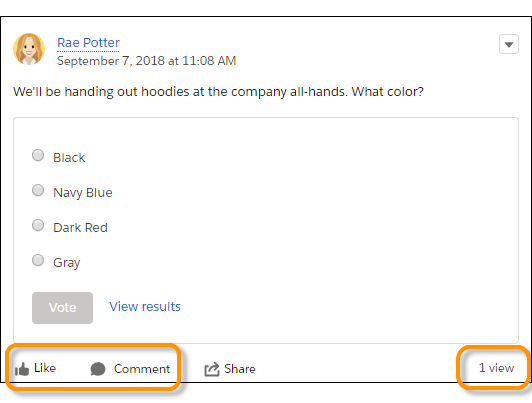
In private and unlisted groups, you can see both how many and who has seen a post.
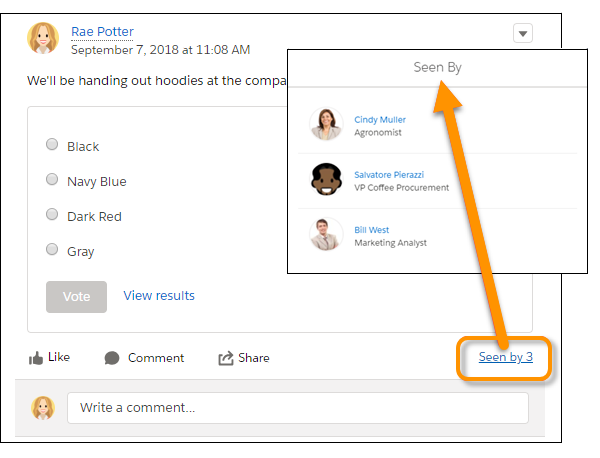
There are lots of other actions you can take on a post. You can also:
- Share a post with a group or the people who follow you.
- Get a link to a post’s detail view.
- Bookmark a post so you can easily find it later.
- Mute a post so you stop receiving notifications about it.
- Edit or delete your own posts.
- Draft a post and publish it later.
Let’s see these actions in action.
Share a Post
If you see a post and want to share it, you can do that right from the post.
- Go the Chatter post that you want to share and click
 the Share icon.
the Share icon.
- To share the post with a group, select Share with Group.
- To share the post on your profile page so that your followers see it, select Share with Followers.
- To copy a link that goes to the detail view of a post, select Copy Link.
- For Share with Group only: In the Group Name field, enter the name of the group to share this post with, and select the group from the results.
- Add any remarks that you want to publish with the shared post.
- Click Share.
If you shared with your followers, the original post and your added remarks are posted to your profile. They also appear in the What I Follow feed of anyone who’s following you. The folks with access to your profile can see the shared post on your profile page, but only the people who follow you are notified. (More on notifications in unit 4.) If you shared with a group, the original post, plus your added remarks, are posted to the group that you specified.
Shared posts have a View Original Post link that takes people back to the original post.
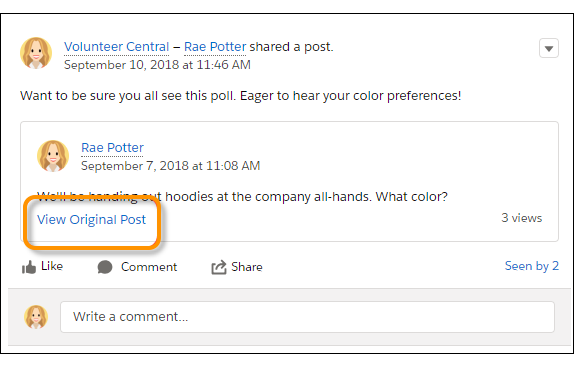
Here are some notes about sharing posts in Lightning Experience.
What you can do |
What you can’t do |
|
|---|---|---|
Where you can share |
Share a post with all your followers and with a group. Copy a link to the detailed view of a post. |
Share a post with multiple groups in one action. |
How you can change the post |
Comment on a shared post. |
Edit the shared instance of the original post. (However, in Lightning Experience, edits to the original post appear in the shared version.) |
What you can share |
Share a post from a group or someone’s personal feed. |
Share a post from a record feed. |
What is shared |
Share the text of the original post. |
Share the original post’s comments or attached files. |
The posts that you share in Lightning Experience keep their connection to the original post. So, if someone edits the original, those changes appear in the shared version.
Edit, Delete, and Bookmark a Post
Sometimes we post something without taking a second look. Oops, a typo! Don’t worry, it doesn’t have to live forever.
To see a post’s Edit and Delete options, click its actions menu icon  .
.

Notice the Bookmark option? Click it to add the post to your Bookmarked feed on the Chatter page. Any post that you bookmark shows a star in its top-right corner in its original feed.
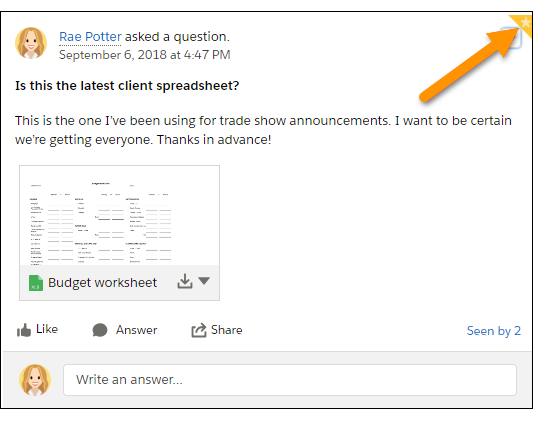
Mute a Post
The more your network heats up with activity, the more notifications you get. It can be helpful to selectively mute certain posts. Muting stops Chatter from sending emails that announce when people act on a post that you’ve liked, commented on, or bookmarked.
Imagine that you post a happy birthday message to your CEO. Suddenly, your email queue is flooded with notifications that all your colleagues have liked or commented on this post. In minutes, your email queue is overwhelmed with notifications.
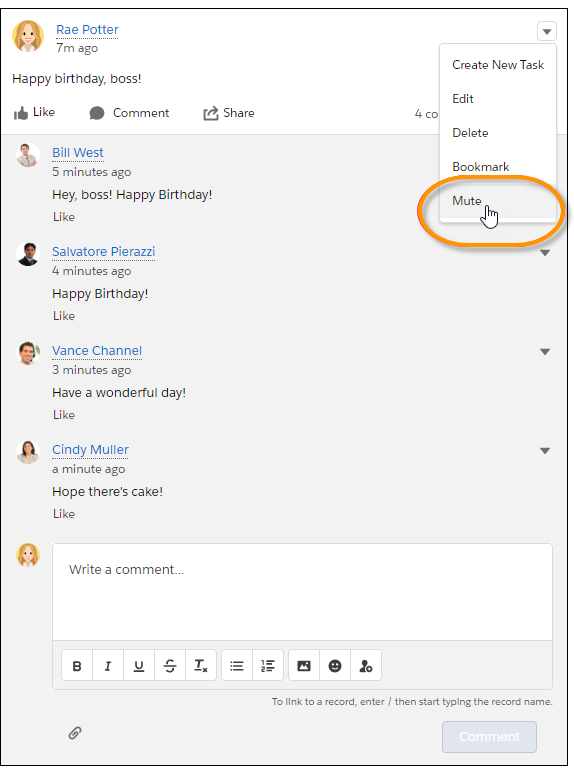
Before your head explodes, try muting.
- Go to the post’s detail view by clicking the link in your notification email. If you’re in the feed, you can also get to a detail view by clicking the post’s date-and-time stamp.

- Click
 the post’s actions menu icon, and select Mute.
the post’s actions menu icon, and select Mute.
Voilà! No more email notifications for that post. You can restore notifications for a muted post by taking the same steps. But this time, select Unmute.
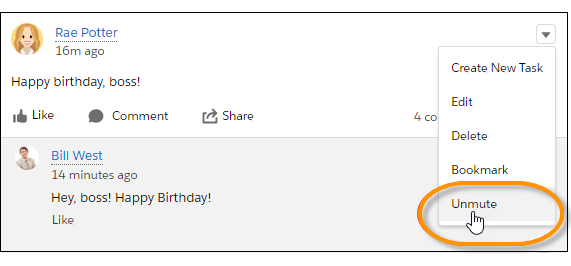
Tip: There are many actions that you can perform from an email notification. For example, you can mute a post from email. For more information, see the links in the Resources section of this unit.
Save and Publish Draft Posts
If your admin has set it up, any post that you haven’t published is automatically saved as a draft after seven seconds. You can find your drafts on the Chatter home page under My Drafts. From My Drafts, you can post or delete the draft. Add files, links, images, mentions, hashtags, and any other rich text to your post, because we save it all. For draft posts with hashtags, the topic isn’t created until you publish the post. Only posts are saved as drafts; questions and polls are not.
Follow People, Groups, and Records
Following is the way to really get your network buzzing. You can follow people, groups, and even records (like work items, accounts, and opportunities). All the people and things that you follow have their own feeds, and when you follow most feeds, you get notified about feed activity.
Notifications arrive in your email and through in-app notifications. (Remember the bell?) And the activity itself, such as a post or a comment, appears in your What I Follow feed.
How do you follow someone? There are lots of ways. For example, wherever you see a name in a feed, hover over it to open a quick view of that person’s profile. Click Follow.
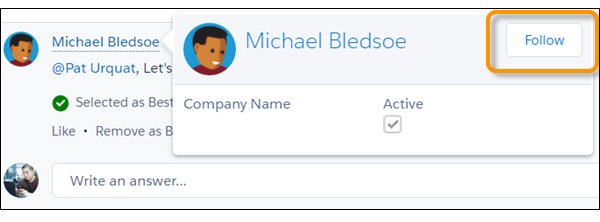
You can also follow someone from their profile page, or you can follow a record from its home page. To follow a record, open the record, click Follow, and select What I Follow.

You can follow any person or record that you have access to.
Tip: Follow groups by joining them (or by being added to them). What are groups? Find out in the next unit!
Want to see all the latest posts from all the people, records, and groups that you follow? Go to your Chatter tab and click What I Follow.

Mention for Attention
A sure way to bring content to someone’s attention is to comment on it and then mention the person in the comment. Your mention appears in the mentioned person’s To Me feed on the Chatter page. Depending on the mentioned person’s notification settings, notifications appear in in-app notifications and via email. We talk more about notifications in unit 4.
To mention someone, enter the @ symbol and start entering their name. A list of suggested matches opens, and you can choose a name from the list.
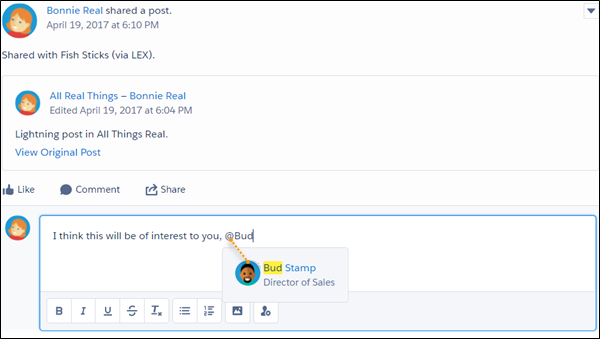
Tip: If you mention someone in a group or on a record that they don’t have access to, they’re not notified. But the mention becomes an active link to their profile or, for an external user, to their user record.
You can also mention groups. Group mentions appear in the group’s feed. Group mentions are a great way to share a relevant post from one feed to another. Access rules apply here, too. If some group members don’t have access to the mentioned group, they don’t see the shared content in their group feed. Clicking a group mention takes you to the group page. If you don’t have access to the group, you see only the group header.
You can link to records in your posts using a similar mechanism. Instead of the @ symbol, enter a forward slash (/) and start typing the record name. A selection of matching records pops up.
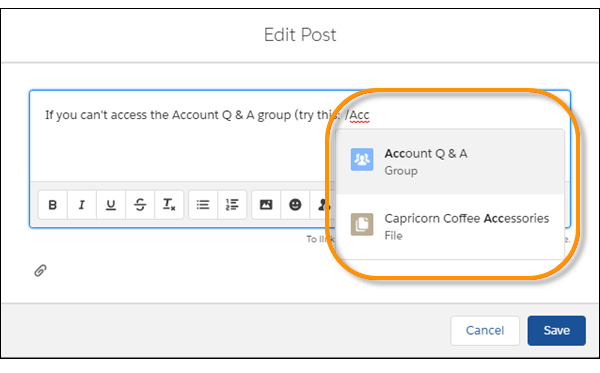
Click a result to add a link to it to your post.

Tip: You can link to any record type that’s enabled for your org, such as work records, accounts, opportunities, groups, people, and cases. Link to up to 25 records in a post or a comment.
Who Sees What?
Here are some guidelines to help you know who can see what in Chatter. Let’s use our chatty Chatter expert, Rachael, as an example. Imagine that you follow Rachael. Depending on where she posts, let’s see what appears in your What I Follow feed.
Where Rachael posts |
Do you see her post in What I Follow? |
|---|---|
On her own profile |
In orgs where all users are public: If you’re following Rachael, you see her posts to her own feed. In orgs where users are default private: If you’re following Rachael, you see her posts to her own feed. You can see posts that appear on Rachael’s profile when these conditions are met:
|
On another person’s profile |
If you are following the other person |
In a public group |
If you follow the group by joining it |
In an unlisted, private, or customer group |
If you’re also a member of the group |
On a record page |
If you have access to the record and you’re following it |
What else can Rachael show us about Chatter? She’s a pro at mentioning people and groups and has the following tips:
-
Put mentions in comments. Rachel places her mentions in the post’s comments. Why? Placing mentions in comments prevents anyone or any group that’s mentioned from getting notified repeatedly whenever there’s action on the post. For example, when you share a post, the post is shared but not the comments. So mentions in comments don’t trigger unwanted notifications when you share the post.
-
Use mentions thoughtfully. You can make every name you enter a mention, but it counts most when a mention triggers a less-frequent and more meaningful notification.
-
Make mentions count. Where your post lives can affect whether the person or group you mention is notified or has access to the post. Here are some examples.
Where you post |
Who you can mention |
|---|---|
On a person’s profile |
Anyone with access to that person |
On a public group |
Anyone with access to the public group |
On a private or unlisted group |
Only members of the group (note that people with special privileges, like “Manage Unlisted Groups” or “Modify Unlisted Groups,” can also see the mentioned post) |
On a record detail page |
Anyone with access to the record |
Now you’ve got your network really buzzing! Next, let’s talk about creating groups for discussing specific work; combining related feeds into one easy-reference feed, called a stream; and setting up your notifications.
Resources
-
Salesforce Help: Reply to Chatter Email Notifications
-
Salesforce Help: Share a Chatter Post
-
Salesforce Help: Mute a Post
-
Salesforce Help: @Mention People and Groups in Posts and Comments
-
Salesforce Help: Who Can See My Attached Files and Links?
-
Salesforce Help: Post Visibility
-
Salesforce Help: Visibility of User and Group @Mentions
-
Salesforce Help: Link to a Record from a Post or Comment
